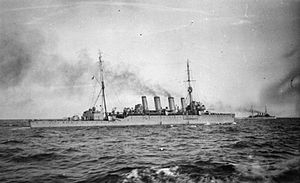| HMS Southampton (1912) | |
|---|---|
 | |
| Career | |
| Class and type: | "Town" class light cruiser |
| Name: | HMS Southampton |
| Builder: | Vickers Maxim, Barrow |
| Laid down: | 6 April 1911 |
| Launched: | 16 May 1912 |
| Fate: | Sold 13 July 1926 |
| General characteristics | |
| Displacement: | 5,400 tons |
| Length: |
430 ft (130 m) 457 ft (139 m) overall |
| Beam: | 49 ft 10 in (15.19 m) |
| Draught: | 17 ft 8 in (5.38 m) (maximum) |
| Propulsion: |
Yarrow boilers Curtis turbines coal and oil fuels |
| Speed: |
25,000 shp = 25.5&n knots Trials:26,006 shp = 26.5 knots |
| Complement: | 429 to 440 men |
| Armament: |
8 × BL 6-inch (152.4 mm) Mk XI guns |
HMS Southampton was a light cruiser in the Royal Navy that served in the First World War.
Southampton was one of the third batch of "Town" class light cruisers; her sister ships were Dublin and Chatham. The first three "Town" ships of the Royal Australian Navy (HMAS Melbourne, HMAS Sydney, and HMAS Brisbane) were virtually identical.
Southampton differed from her sisters in that she had different machinery. Chatham had two screws. The sister ships, with Parsons turbines, had four screws.
The ship had an extremely active wartime career. As flagship of the 1st Light Cruiser Squadron of the Grand Fleet, she participated in the Battle of Heligoland Bight, and later in the Battle of Dogger Bank.
In 1916, Southampton fought in the Battle of Jutland as flagship of 2nd Light Cruiser Squadron where she torpedoed the German light cruiser SMS Frauenlob, which subsequently sank. In 1917, she had been moved to the 8th Light Cruiser Squadron.
Southampton was sold for scrapping on 13 July 1926 to Ward, of Pembroke Dock.
References[]
- Colledge, J. J.; Warlow, Ben (2006) [1969]. Ships of the Royal Navy: The Complete Record of all Fighting Ships of the Royal Navy (Rev. ed.). London: Chatham Publishing. ISBN 978-1-86176-281-8. OCLC 67375475.
- Jane's Fighting Ships of World War One (1919), Jane's Publishing Company
- Gray, Randal (ed), "Conway's All The Worlds Fighting Ships, 1906-1921", (Conway Maritime Press, London, 1985), ISBN 0-85177-245-5
- Ships of the Chatham group
- A North Sea Diary 1914-1918 Account by Stephen King-Hall, an officer who served on her through the war.
| ||||||||||||||||||||||||||||||
The original article can be found at HMS Southampton (1912) and the edit history here.